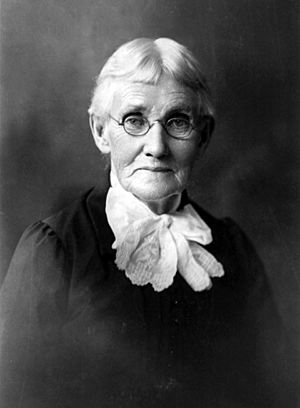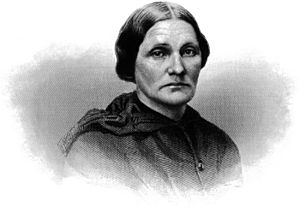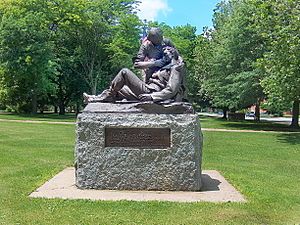Mary Ann Bickerdyke facts for kids
Quick facts for kids
Mary Ann Bickerdyke
|
|
|---|---|

Mary Ann Bickerdyke in 1898
|
|
| Birth name | Mary Ann Ball |
| Nickname(s) | "Mother" Bickerdyke |
| Born | July 19, 1817 Knox County, Ohio |
| Died | November 8, 1901 (aged 84) Bunker Hill, Kansas |
| Buried | |
| Years of service | 1861–1865 |
| Spouse(s) | Robert Bickerdyke |
| Relations | Two sons |
| Other work | lawyer, advocate for veterans |
Mary Ann Bickerdyke (born July 19, 1817 – died November 8, 1901) was a brave woman who helped soldiers during the American Civil War. People often called her Mother Bickerdyke because she cared for the soldiers like a mother. She helped set up many hospitals for Union soldiers. After the war, she continued to help veterans and their families.
Contents
Early Life and Beginnings
Mary Ann Ball was born on July 19, 1817, in Knox County, Ohio. She was one of the first women to attend Oberlin College in Ohio. In 1847, she married Robert Bickerdyke. He passed away in 1859, two years before the Civil War began. They had two sons together.
Later, she moved to Galesburg, Illinois. There, she worked as a botanic physician, using herbs and plants to help people. She started attending the Congregational Church in Galesburg after her husband died.
Helping Soldiers in the Civil War
Mary Bickerdyke served during the Civil War from 1861 to 1865. She worked at nineteen different battles. She was known as a very determined nurse. She would not let anything stop her from doing her job.
Soldiers called her "Mother" Bickerdyke because she was so caring. Once, a surgeon questioned her authority. She famously replied, "On the authority of Lord God Almighty, have you anything that outranks that?" Her real authority came from her good reputation and how much the soldiers liked her.
Starting Her Work
A surgeon named Dr. Woodward wrote about the terrible hospitals in Cairo, Illinois. His letter was read in Bickerdyke's church. The people of Galesburg collected $500 worth of supplies. They chose Bickerdyke to deliver them because no one else would go.
She met Mary Livermore, who helped her become a field agent. This meant she worked for the United States Sanitary Commission. Livermore also helped Bickerdyke find care for her two sons. This allowed Bickerdyke to stay with the army.
She stayed in Cairo as a nurse. There, she organized the hospitals and earned the respect of General Ulysses S. Grant. Grant supported her work and even gave her soldiers to help. As his army moved, Bickerdyke went with them, setting up hospitals wherever they were needed. She became a hospital matron in just five months.
Improving Hospitals
She later joined a field hospital at Fort Donelson. There, she worked with Mary J. Safford. At Fort Donelson, she saw that the hospitals needed better laundry services. She gathered dirty clothes and bedding. She sent them to be cleaned and asked for washing machines.
She then organized former slaves to help with laundry. These people had escaped slavery and were now free. They provided important laundry services for the hospitals she set up.
Working with Generals
After Fort Donelson, she became a matron at Gayoso Block Hospital in Memphis. This hospital had 900 patients, including many Native Americans. "Mother" Bickerdyke also hired former slaves to help at Gayoso.
Once, a medical director sent away her helpers. Bickerdyke went to General Stephen A. Hurlbut and got written permission to keep her employees. She also got cows and hens to provide fresh milk and eggs for the hospital. General Hurlbut even set aside land for the animals.
Bickerdyke also worked closely with Eliza Emily Chappell Porter. She later worked on the first hospital boat. During the war, she became chief of nursing under General Grant. She served at the Siege of Vicksburg.
As chief of nursing, Bickerdyke sometimes ignored military rules. When Grant's staff complained, General William Tecumseh Sherman famously said, "She outranks me. I can't do a thing in the world." Sherman called her "one of his best generals." Other officers called her the "Brigadier Commanding Hospitals." Both General Sherman and General Grant liked her and often gave her whatever she asked for.
Battles and Compassion
On October 27, 1863, Bickerdyke went to Chattanooga. She saw the Battle of Lookout Mountain, also called "the battle above the clouds." She wrote in a letter, "I watched the dreadful combat until the clouds hid all from view."
Bickerdyke set up the field hospital for the Fifteenth Army Corps at the Battle of Missionary Ridge. She was the only female attendant there for four weeks. She also collected personal items from soldiers who died. She made sure these items were sent back to their families.
During the march to capture Atlanta, Georgia, General Sherman ordered his troops to damage the enemy's resources. But Bickerdyke still worked to build hospitals for Confederate soldiers too. This showed her great compassion.
By the end of the war, "Mother" Bickerdyke had helped build 300 hospitals. She aided the wounded on 19 battlefields, including the Battle of Shiloh and Sherman's March to the Sea. Soldiers loved her so much that they would cheer when she appeared. At Sherman's request, she rode at the front of the XV Corps in the Grand Review of the Armies in Washington. This parade celebrated the end of the war.
Life After the War
After the war, Bickerdyke continued to help others. In 1866, she worked at the Home for the Friendless in Chicago. She also helped fifty veterans' families move to Salina, Kansas. There, they could become homesteaders, meaning they could claim land.
She ran a hotel there with General Sherman's help. It was first called the Salina Dining Hall, but later became known as the Bickerdyke House. Later, she became an attorney. She helped Union veterans with legal problems, like getting their pensions. Pensions are regular payments given to people who have served.
General Logan helped her get a job at the San Francisco Mint. She also worked for The Salvation Army there. In California, she was chosen as the first president of a group called Lyon Women's Relief Corps. This group helped veterans. She declined the position but was a founding member.
Mary Livermore helped Bickerdyke receive a special pension of $25 a month from Congress. Generals Grant, Sherman, Pope, and Long spoke in favor of this bill. It passed on May 9, 1886.
Bickerdyke retired to Bunker Hill, Kansas to live with her son. She passed away peacefully in 1901 after a small stroke. She was buried in Galesburg, Illinois.
Legacy and Recognition
Clara Barton wrote a poem called "The Women Who Went to the Field." This poem honored Bickerdyke and other brave women.
Statues of Mary Ann Bickerdyke have been built in Galesburg, Illinois and Mount Vernon, Ohio. The United States government honored her military achievements. They named a hospital ship and a liberty ship the SS Mary Bickerdyke. The ship was launched in October 1943.
In Galesburg, Illinois, an overpass opened in 2014. It is officially named "Bickerdyke Bridge" in her honor.



